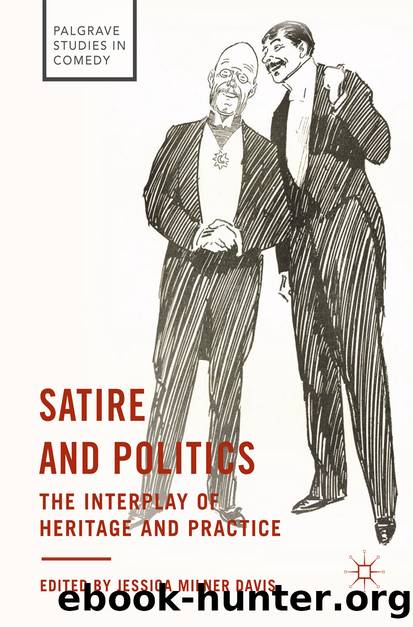Satire and Politics by Jessica Milner Davis

Author:Jessica Milner Davis
Language: eng
Format: epub
Publisher: Springer International Publishing, Cham
Political Cartoons as Cultural Mirrors
Koelble and Robinsâ (2007) view of satire as a moral mirror 31 is rooted in antiquity and shared by many scholars. Nearly 44% of the texts examined in this survey focused on the various ways in which political cartoons reflect individuals, audiences or society at large. Gail Dines (1995) draws on Careyâs (1977) criticism of simplistic communication models to argue for a more sociological approach that locates the production and consumption of political cartoons in the relevant social, economic and political contexts. She points out that sociologists are interested in how cartoons function as mechanisms for social control, reflecting conflict and maintaining dominant social structures. She critiques research from the 1970s and 1980s as focusing too heavily on statistical data without giving sufficient qualitative content analysis of the kind that would provide powerful insight into shared notions of social reality.
Streicherâs (1965) study of David Lowâs cartoons exemplifies how cartoons âconvey deeper meanings of social situationsâ. 32 Low is shown to deploy âfool ascriptionâ through his fictitious âColonel Blimpâ character in order to destabilise social relations or political structures. Cartoons have also been seen (e.g. in the work of Thibodeau 1989) simply as reflections of the publicâs (generally negative) impressions of the subjects depicted. Cahn (1984) views them negatively because the biases of cartoonists are clearly represented. Despite this, Kemnitz (1973) underscores that they can be an important historical source. Scholars such as Brabant and Mooney (1997), Chavez (1985) and Kasen (1980) point out that comics in general can and do reflect public beliefs and attitudes, making it possible to trace persistent or changing cultural patterns. Instances of this are the gender issues studied by Brabant and Mooney (1986), Manning (2008), Mooney and Brabant (1990) and Orbuch and Custer (1995). Charlotte Templinâs (1999) study of cartoon depictions of Hillary Clinton adds a twist to this gender angle. By dividing a large corpus into eight femininity and female role themes, she shows how cartoonists across the political spectrum depicted the then First Lady as transgressing conservative gender norms. Templin concludes that this reveals a persistence of traditional perceptions despite women's changing social position.
Cartoons can also reflect on issues of ethnicity, as shown in Soperâs (2005) historical content analysis of âcomplex patterns of identification, sympathy and denigration in cartoon representationsâ 33 of the Irish in America. Soper is interested in the effect of exaggeration aimed at a whole ethnic group and concludes that the loss of such ethnic comedy results in a masking of political purposes, which in turn sponsors the rise of more subversive forms of satire. Similarly, Conners (2010) uses cartoons from the 2008 US presidential campaign to investigate public opinion about race and gender, as does Gilmartin (2001) for that in 2000.
Press (1981) and Morris (1992) both use cartoons to gain insights into public perceptions of ruling figures. Danjoux (2005), drawing on Pressâs four levels of understanding cartoons, puts forward the study of political cartoons on international disputes as a way âto provide insight into interests
Download
This site does not store any files on its server. We only index and link to content provided by other sites. Please contact the content providers to delete copyright contents if any and email us, we'll remove relevant links or contents immediately.
| Anthropology | Archaeology |
| Philosophy | Politics & Government |
| Social Sciences | Sociology |
| Women's Studies |
Cecilia; Or, Memoirs of an Heiress — Volume 1 by Fanny Burney(32412)
Cecilia; Or, Memoirs of an Heiress — Volume 3 by Fanny Burney(31822)
Cecilia; Or, Memoirs of an Heiress — Volume 2 by Fanny Burney(31802)
The Great Music City by Andrea Baker(31249)
We're Going to Need More Wine by Gabrielle Union(18951)
All the Missing Girls by Megan Miranda(15491)
Pimp by Iceberg Slim(14319)
Bombshells: Glamour Girls of a Lifetime by Sullivan Steve(13952)
Talking to Strangers by Malcolm Gladwell(13185)
Norse Mythology by Gaiman Neil(13170)
Fifty Shades Freed by E L James(13145)
For the Love of Europe by Rick Steves(12646)
Mindhunter: Inside the FBI's Elite Serial Crime Unit by John E. Douglas & Mark Olshaker(9160)
Crazy Rich Asians by Kevin Kwan(9147)
The Lost Art of Listening by Michael P. Nichols(7388)
Enlightenment Now: The Case for Reason, Science, Humanism, and Progress by Steven Pinker(7164)
The Four Agreements by Don Miguel Ruiz(6597)
Bad Blood by John Carreyrou(6519)
Weapons of Math Destruction by Cathy O'Neil(6116)
